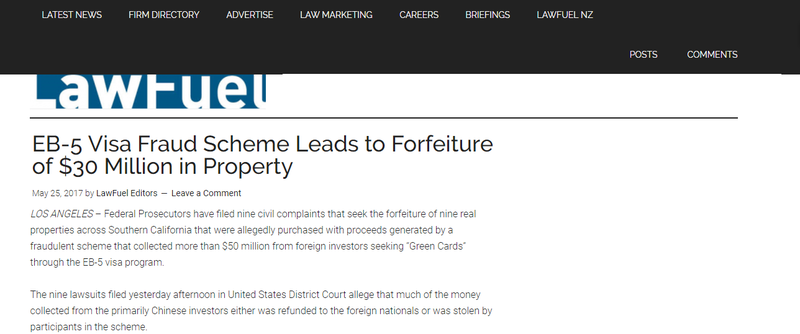EB-5 Visa Fraud Scheme Leads to Forfeiture of $30 Million in Property
Federal Prosecutors have filed nine civil complaints that seek the forfeiture of nine real properties across Southern California that were allegedly purchased with proceeds generated by a fraudulent scheme that collected more than $50 million from foreign investors seeking “Green Cards” through the EB-5 visa program.
The nine lawsuits filed yesterday afternoon in United States District Court allege that much of the money collected from the primarily Chinese investors either was refunded to the foreign nationals or was stolen by participants in the scheme.
The asset forfeiture complaints allege that attorney Victoria Chan and her father, Tat Chan, operated a business called California Investment Immigration Fund, LLC (CIIF) from 2008 until this year. In April, authorities executed federal search warrants as part of an ongoing investigation.
According to the lawsuits filed yesterday, CIIF exploited the EB-5 visa program, which provides lawful permanent residence – commonly known as a “Green Card” – to foreign nationals who invest at least $500,000 in a domestic business that creates 10 new American jobs. Those involved in the scheme allegedly convinced more than 100 Chinese nationals to invest over $50 million in CIIF and related companies.
“Rather than legitimately investing the funds into American businesses, CIIF either refunded the funds to the EB-5 investors while the investors’ EB-5 petitions were pending, in direct violation of the EB-5 program, or stole millions of dollars to use for personal expenditures, including buying million-dollar homes,” according to the lawsuits that allege “many foreign nationals were able to improperly obtain U.S. green cards.”
The lawsuits allege that the properties named in the asset forfeiture lawsuits were purchased with proceeds derived from mail fraud, wire fraud or visa fraud and that the purchases themselves constituted money laundering.
The lawsuits seek the forfeiture of nine properties:
- a commercial property in the City of Industry valued at over $3 million;
- five residences in the cities of Rancho Cucamonga, Arcadia (worth approximately $4 million), Diamond Bar, Riverside and Duarte (valued at $5.5 million); and
- parcels of land located in Ontario, Indio (worth nearly $6 million) and Rancho Cucamonga (valued at more than $7.7 million).
The asset forfeiture lawsuits contain allegations only. In order to forfeit the properties named in the complaints, the government must show by a preponderance of the evidence that the properties were purchased with proceeds derived from criminal activity.
The ongoing investigation into the EB-5 fraud scheme is being conducted by the FBI and U.S. Immigration and Customs Enforcement’s Homeland Security Investigations.
The asset forfeiture complaints were filed by Assistant United States Attorney Jonathan Galatzan of the Asset Forfeiture Section.
http://www.lawfuel.com/blog/eb-5-visa-fraud-scheme-leads-forfeiture-30-million-property/
Mentions
States
- California
Securities Disclaimer
This website is for informational purposes only and does not constitute an offer or solicitation to sell shares or securities. Any such offer or solicitation will be made only by means of an investment's confidential Offering Memorandum and in accordance with the terms of all applicable securities and other laws. This website does not constitute or form part of, and should not be construed as, any offer for sale or subscription of, or any invitation to offer to buy or subscribe for, any securities, nor should it or any part of it form the basis of, or be relied on in any connection with, any contract or commitment whatsoever. EB5Projects.com LLC and its affiliates expressly disclaim any and all responsibility for any direct or consequential loss or damage of any kind whatsoever arising directly or indirectly from: (i) reliance on any information contained in the website, (ii) any error, omission or inaccuracy in any such information or (iii) any action resulting therefrom.




